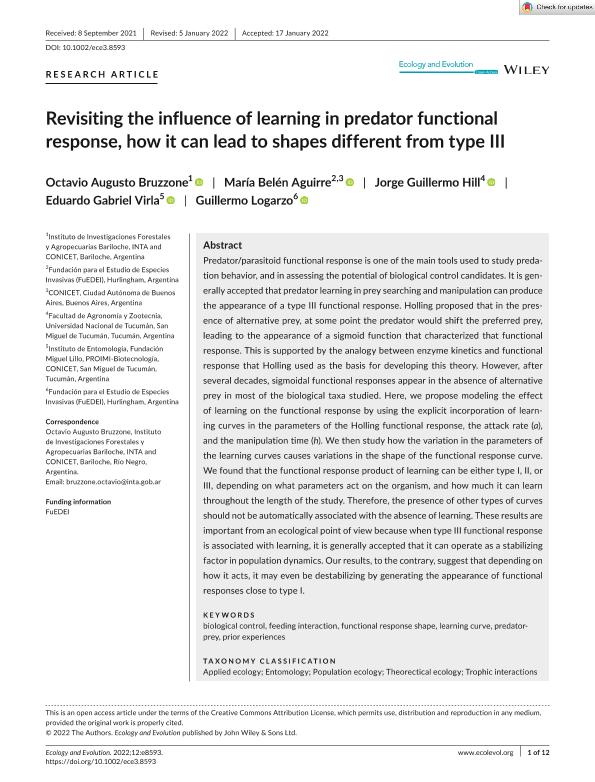Mostrar el registro sencillo del ítem
dc.contributor.author
Bruzzone, Octavio Augusto

dc.contributor.author
Aguirre, María Belén

dc.contributor.author
Hill, Jorge Guillermo

dc.contributor.author
Virla, Eduardo Gabriel

dc.contributor.author
Logarzo, Guillermo Alejandro

dc.date.available
2023-08-30T14:47:40Z
dc.date.issued
2022-02
dc.identifier.citation
Bruzzone, Octavio Augusto; Aguirre, María Belén; Hill, Jorge Guillermo; Virla, Eduardo Gabriel; Logarzo, Guillermo Alejandro; Revisiting the influence of learning in predator functional response, how it can lead to shapes different from type III; John Wiley & Sons; Ecology and Evolution; 12; 2; 2-2022; 1-12
dc.identifier.issn
2045-7758
dc.identifier.uri
http://hdl.handle.net/11336/209902
dc.description.abstract
Predator/parasitoid functional response is one of the main tools used to study predation behavior, and in assessing the potential of biological control candidates. It is generally accepted that predator learning in prey searching and manipulation can produce the appearance of a type III functional response. Holling proposed that in the presence of alternative prey, at some point the predator would shift the preferred prey, leading to the appearance of a sigmoid function that characterized that functional response. This is supported by the analogy between enzyme kinetics and functional response that Holling used as the basis for developing this theory. However, after several decades, sigmoidal functional responses appear in the absence of alternative prey in most of the biological taxa studied. Here, we propose modeling the effect of learning on the functional response by using the explicit incorporation of learning curves in the parameters of the Holling functional response, the attack rate (a), and the manipulation time (h). We then study how the variation in the parameters of the learning curves causes variations in the shape of the functional response curve. We found that the functional response product of learning can be either type I, II, or III, depending on what parameters act on the organism, and how much it can learn throughout the length of the study. Therefore, the presence of other types of curves should not be automatically associated with the absence of learning. These results are important from an ecological point of view because when type III functional response is associated with learning, it is generally accepted that it can operate as a stabilizing factor in population dynamics. Our results, to the contrary, suggest that depending on how it acts, it may even be destabilizing by generating the appearance of functional responses close to type I.
dc.format
application/pdf
dc.language.iso
eng
dc.publisher
John Wiley & Sons

dc.rights
info:eu-repo/semantics/openAccess
dc.rights.uri
https://creativecommons.org/licenses/by/2.5/ar/
dc.subject
BIOLOGICAL CONTROL
dc.subject
FEEDING INTERACTION
dc.subject
FUNCTIONAL RESPONSE SHAPE
dc.subject
LEARNING CURVE
dc.subject
PREDATOR-PREY
dc.subject
PRIOR EXPERIENCES
dc.subject.classification
Biología

dc.subject.classification
Ciencias Biológicas

dc.subject.classification
CIENCIAS NATURALES Y EXACTAS

dc.title
Revisiting the influence of learning in predator functional response, how it can lead to shapes different from type III
dc.type
info:eu-repo/semantics/article
dc.type
info:ar-repo/semantics/artículo
dc.type
info:eu-repo/semantics/publishedVersion
dc.date.updated
2023-07-10T10:38:05Z
dc.journal.volume
12
dc.journal.number
2
dc.journal.pagination
1-12
dc.journal.pais
Estados Unidos

dc.journal.ciudad
New Jersey
dc.description.fil
Fil: Bruzzone, Octavio Augusto. Instituto Nacional de Tecnología Agropecuaria. Centro Regional Patagonia Norte. Estación Experimental Agropecuaria San Carlos de Bariloche. Instituto de Investigaciones Forestales y Agropecuarias Bariloche. - Consejo Nacional de Investigaciones Científicas y Técnicas. Centro Científico Tecnológico Conicet - Patagonia Norte. Instituto de Investigaciones Forestales y Agropecuarias Bariloche; Argentina
dc.description.fil
Fil: Aguirre, María Belén. Fundación para el Estudio de Especies Invasivas; Argentina. Consejo Nacional de Investigaciones Científicas y Técnicas; Argentina
dc.description.fil
Fil: Hill, Jorge Guillermo. Universidad Nacional de Tucumán; Argentina. Consejo Nacional de Investigaciones Científicas y Técnicas. Centro Científico Tecnológico Conicet - Tucumán. Planta Piloto de Procesos Industriales Microbiológicos; Argentina
dc.description.fil
Fil: Virla, Eduardo Gabriel. Fundación Miguel Lillo; Argentina. Consejo Nacional de Investigaciones Científicas y Técnicas. Centro Científico Tecnológico Conicet - Tucumán. Planta Piloto de Procesos Industriales Microbiológicos; Argentina
dc.description.fil
Fil: Logarzo, Guillermo Alejandro. Fundación para el Estudio de Especies Invasivas; Argentina
dc.journal.title
Ecology and Evolution
dc.relation.alternativeid
info:eu-repo/semantics/altIdentifier/url/https://onlinelibrary.wiley.com/doi/full/10.1002/ece3.8593
dc.relation.alternativeid
info:eu-repo/semantics/altIdentifier/doi/http://dx.doi.org/10.1002/ece3.8593
Archivos asociados
